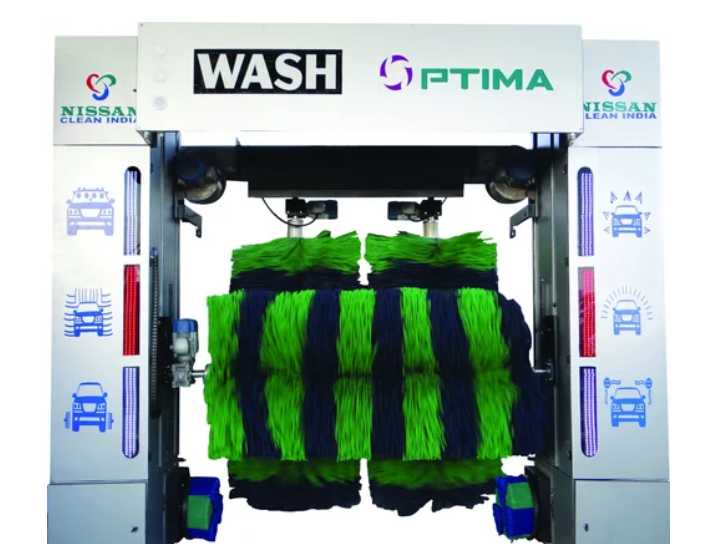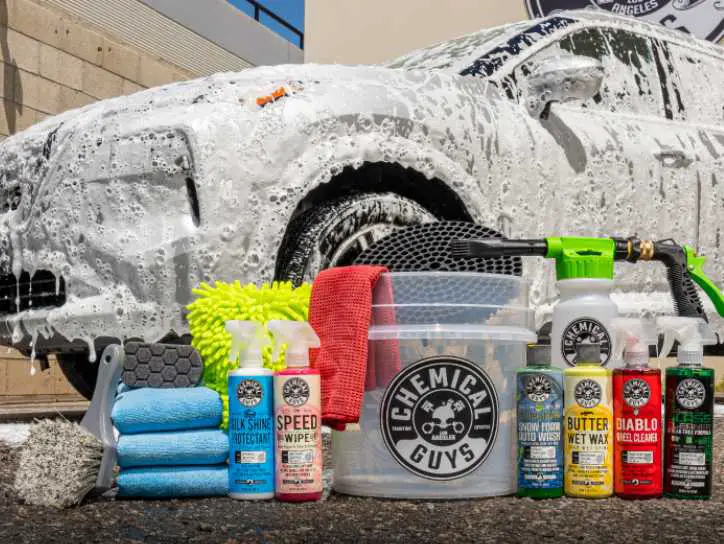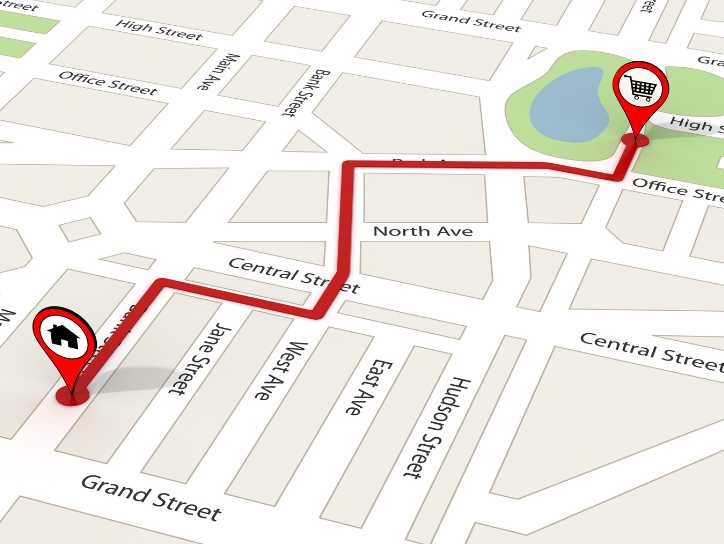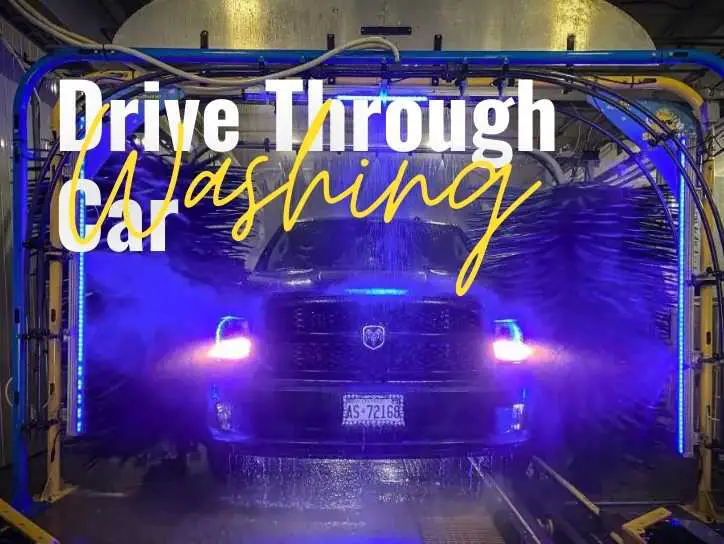A drive-through car washing system, also known as an automatic or touchless car wash, is a mechanized facility designed to clean and wash vehicles automatically without requiring manual labour.
In this type of car wash, the vehicle owner drives their car into a specialized bay or area, and the cleaning process is initiated by automated machinery and systems.
Benefits of drive-through car washing systems include time efficiency, consistent cleaning results, and, in some cases, environmental considerations such as water conservation and the use of eco-friendly cleaning agents.
These automated systems are popular for their convenience and ability to handle a high volume of vehicles in a short amount of time.
Benefits of Using a Drive-Through Car Washing Service

For a car owner, the importance of using a drive-through car washing system lies in several key benefits:
- Time Efficiency: It offers a quick and efficient way to clean your vehicle. The automated process is usually faster compared to washing your car manually, allowing you to save time and effort.
- Consistent Cleaning Results: These systems are designed to provide consistent and uniform cleaning results. Automated processes ensure that every part of your vehicle is cleaned thoroughly, leaving a polished and well-maintained appearance.
- Preservation of Vehicle’s Exterior: Regular cleaning helps to preserve the exterior of your car by removing dirt, road salt, bird droppings, and other contaminants. This is important for preventing long-term damage to the paint, which can lead to rust and deterioration.
- Convenience and Accessibility: Drive-through car washes are readily available in many locations, making them convenient for car owners. Whether you’re on a busy schedule or simply want a hassle-free cleaning experience, these facilities offer accessibility and ease of use.
- Time-Saving Alternative to Manual Washing: While manual car washing can be a satisfying activity for some car enthusiasts, it can be time-consuming and physically demanding. DTCW system provides a time-saving alternative, allowing you to keep your vehicle clean without the need for hands-on labour.
- Environmental Considerations: Some drive-through car washing brands use environmentally friendly practices, such as water recycling and the use of eco-friendly cleaning agents. This can align with the environmentally conscious choices of car owners who want to minimize their ecological impact.
- Preservation of Resale Value: Regular cleaning and maintenance contribute to preserving the resale value of your car. A well-maintained and clean vehicle is more likely to attract potential buyers and can command a higher resale price.
- Protection Against Harsh Elements: It helps protect your vehicle against harsh elements like UV rays, road salt, and acidic contaminants. Regular cleaning can extend the life of your car’s exterior and keep it looking newer for a longer time.
Types of Drive-Through Car Washing Systems
Drive-through car washing systems come in various types, each employing different technologies and methods to clean vehicles efficiently. You will frequently see touchless and friction systems. Here’s an overview of each:
1. Touchless Systems
Touchless car wash systems utilize high-pressure water jets and a combination of detergents and cleaning chemicals to remove dirt and contaminants from the vehicle’s surface.
Advantages:
- Reduced Scratching: Since there is no physical contact between the cleaning equipment and the vehicle, the risk of scratching or damaging the paint is minimized.
- Versatility: Touchless systems can accommodate a wide range of vehicle sizes and shapes.
- Quick Process: These systems are known for their speed and efficiency, providing a rapid cleaning process.
2. Friction Systems
Friction-based car wash systems use brushes, cloth materials, or a combination of both to physically scrub away dirt and contaminants from the vehicle’s surface.
Advantages:
- Effective Cleaning: Friction systems are known for their effectiveness in removing stubborn dirt and grime.
- Polishing: Some friction systems include brushes that can provide a polishing effect on the vehicle’s surface.
- Customization: These systems can be customized with various types of brushes to accommodate different cleaning needs.
3. Combination Systems
Some car wash facilities use a combination of touchless and friction methods in a single system. This approach aims to combine the strengths of both technologies for a comprehensive cleaning process.
Advantages:
- Comprehensive Cleaning: Combining touchless and friction elements can result in a more thorough and versatile cleaning process.
- Flexibility: The system can adapt to different levels of dirt and various vehicle types.
4. In-Bay Automatics (IBA)
In-bay automatic car washes are often found in gas stations and convenience stores. They use a combination of automated equipment, such as sprayers and brushes, to clean the vehicle.
Advantages:
- Convenience: In-bay automatics are convenient for car owners as they are often available in easily accessible locations.
- Automated Process: These systems provide a hands-free and automated cleaning experience.
5. Tunnel Systems
Tunnel car wash systems involve a conveyor belt that moves the vehicle through a tunnel-like structure, where various cleaning components are stationed.
Advantages
- Efficiency: Tunnel systems are designed for high-volume cleaning, making them suitable for busy car wash facilities.
- Consistency: The conveyor ensures a consistent speed and timing for each vehicle, resulting in uniform cleaning.
Average Price of a Drive-Through Car Wash
On average, a basic drive-through car washes typically range between $5 to $15. However, the price of a car wash can vary depending on several factors, including the location, the type of car wash, and any additional services offered.
| Wash Type | Description | Price Range |
| Basic Wash | Standard wash with high-pressure water and soap | $5 – $10 |
| Standard Wash | Includes undercarriage and wheel cleaning | $10 – $15 |
| Premium Wash | Additional features like triple-foam wax | $15 – $25 or more |
| Unlimited Memberships | Monthly memberships for unlimited washes | $20 – $50 per month |
Components of Drive-Through Car Washing Systems
Drive-through car washing systems typically consist of various components and follow a specific process to clean vehicles efficiently.
Please note: Exact equipment and process can vary among different car wash system brands. Below is a general overview for a vehicle owner.
- Entrance Gate: Sensors or manual entry for vehicles to enter the car wash area.
- Payment Station: Payment kiosk or automated payment system where customers pay for the car wash.
- Traffic Control System: Traffic lights or signals to guide vehicles through the car wash in an organized manner.
- Pre-Wash Area: High-pressure pre-wash sprayers to remove loose dirt and debris (Pre-soak arches that apply a chemical solution to help loosen dirt).
- Brushes and Friction Cleaning: Soft or cloth brushes that rotate or move horizontally to scrub the vehicle’s surface. Other side, wheel brushes for cleaning tires.

- Detergent Application: Detergent dispensers or arches that apply soap or cleaning solution to the vehicle.
- High-Pressure Rinse: High-pressure rinse arches that use water to remove soap and remaining dirt.
- Spot-Free Rinse: Arch or system that applies a spot-free rinse or water treatment to prevent water spots.
- Drying System: The system uses air dryers or blowers to remove water from the vehicle’s surface. However, in some systems, additional drying materials like cloth or soft fabric may be used.
- Wax and Polish Application (Optional): Wax or polish applicators that apply a protective coating to the vehicle’s surface.
- Exit Gate: Sensors or manual exit points for vehicles to leave the car wash area.
- Tracking System: Conveyor or track system that moves the vehicle through the car wash process.
- Vacuum Stations (Optional): Depending on the service provider brands, you can also take advantage of a vacuum to clean the interior of their vehicles.
How Does Drive-Through Car Washing System Work?
A drive-through car washing system is a mechanized and automated process. Below is a step-by-step explanation of how a typical drive-through car washing system works:
- Entrance and Payment: The process begins when a customer drives their vehicle to the entrance of the car wash facility. At the entrance, there may be a payment kiosk or automated payment system where the customer selects and pays for the desired car wash package.
- Traffic Control System: Once payment is confirmed, a traffic control system guides the vehicle to the starting point of the car wash process. Traffic lights or signals may indicate when the vehicle should move forward.
- Pre-Wash Area: The vehicle enters the pre-wash area, where high-pressure sprayers and pre-soak arches apply a cleaning solution to loosen and remove loose dirt and debris. This step also prepares the vehicle for the main wash process.
- Brushes and Friction Cleaning: The vehicle moves into the main wash section, where rotating brushes or cloth strips clean the vehicle’s surface. I’ve also seen wheel brushes may also be employed to clean the tires and rims.
- Detergent Application: Detergent applicators apply soap or cleaning solution to the vehicle, enhancing the cleaning process. This step helps to break down and remove stubborn dirt and contaminants.
- High-Pressure Rinse: High-pressure rinse arches or nozzles spray water to remove soap and remaining dirt from the vehicle’s surface. This step also prepares the vehicle for the next stages of the process.
- Spot-Free Rinse: Arch or system applies a spot-free rinse or water treatment to prevent water spots from forming on the vehicle. This helps in achieving a streak-free and spot-free finish.
- Drying System: The vehicle moves through a drying system where air dryers or blowers remove water from the vehicle’s surface. I’ve seen some systems may also use additional drying materials such as cloth or soft fabric.
- Optional Wax and Polish Application: If the car wash offers additional services, an optional step may include the application of wax or polish to provide extra protection and shine to the vehicle’s exterior.
- Exit Gate: After completing the cleaning and drying process, the vehicle is guided towards the exit gate. The exit gate may have sensors or be operated manually.
- Customer Exit: The customer exits the car wash facility, and the process is complete.
List of Chemicals Used in Drive-Through Car Wash
Below are different chemicals with their purpose and function:

Pre-Soak or Pre-Wash Chemicals:
- Purpose: These chemicals are applied before the main wash to loosen and lift dirt and grime from the vehicle’s surface.
- Function: Alkaline-based cleaners help break down grease and oil, while detergents and surfactants enhance the cleaning process.
Washing Detergents:
- Purpose: Detergents are the main cleaning agents in the wash process, helping to lift and remove dirt and contaminants.
- Function: pH-balanced detergents ensure effective cleaning without causing damage to the vehicle’s paint or finish. Foaming agents contribute to the formation of thick suds for better coverage.
Wheel and Tire Cleaners:
- Purpose: These chemicals are designed specifically for cleaning wheels and tires, which often have tougher deposits like brake dust.
- Function: Acid-based cleaners can dissolve brake dust, while non-acid versions are gentler on surfaces. Tire brighteners enhance the appearance of the tires.
Wax and Polish Applications:
- Purpose: These chemicals provide a protective layer to the vehicle’s surface, enhancing shine and repelling water.
- Function: Carnauba wax, polymer-based waxes, and silicones create a barrier that protects against environmental contaminants and UV rays. Sealants provide longer-lasting protection.
High-Pressure Rinse Chemicals:
- Purpose: These chemicals aid in the removal of soap and contaminants during the rinse phase.
- Function: Spot-free rinse solutions prevent water spots by altering the water’s chemistry. Water softeners and anti-spotting agents contribute to a streak-free finish.
Undercarriage Wash Chemicals (Optional):
- Purpose: These chemicals target the undercarriage to remove road salt, dirt, and other contaminants.
- Function: Rust inhibitors and corrosion inhibitors help protect metal components. Degreasers break down oily residues.
Protective Coatings:
- Purpose: Applied as a final step, these coatings add an extra layer of protection to the vehicle.
- Function: Clear coat protectants enhance the gloss of the paint, while polymer sealants and UV protectants guard against environmental damage.
Spot-Free Rinse Additives:
- Purpose: Used to achieve a spot-free finish.
- Function: Deionized water and water purifiers or softeners remove minerals from the water, preventing the formation of water spots.
Interior Cleaning Chemicals (for self-serve vacuum stations, if available):
- Purpose: Designed for cleaning the vehicle’s interior surfaces.
- Function: Upholstery cleaners remove stains and dirt from seats and carpets. Interior detailers provide a clean and polished finish. Glass cleaners ensure streak-free windows.
Steps to Choose the Right Brand for Drive-Through Car Washing

When looking for the right brand for a drive-through car washing system, start by searching for reputable brands in your location.
Use phrases like “car wash brands near me” or “find drive-through car wash brands nearby” to narrow down options within your local area. Consider brands that have a strong presence and positive reviews from customers in your region. You can also follow the given approach:
- Research Brands: Identify reputable car wash equipment brands through online research and industry insights.
- Read Reviews: Check customer reviews and testimonials to gauge user satisfaction and reliability.
- Consider Local Presence: Use location-based queries to find brands with a local presence for convenient support and maintenance.
- Evaluate Features: Assess technological features, innovations, and additional services offered by each brand.
- Check Reputation and Support: Consider the brand’s reputation, longevity, and customer support services, ensuring reliability and assistance when needed.
Tips for Using a Drive-Through Car Washing

For better understanding, I’ve listed tips into 3 parts – Preparing, Washing & Post Wash. Let’s understand each of them in detail:
Preparing:
- Remove Personal Items: Take out any loose items from your car, such as trash, personal belongings, or items in the trunk. This ensures nothing gets damaged or lost during the wash.
- Close Windows and Sunroof: Roll up your windows and close your sunroof tightly. This prevents water from entering your car’s interior during the wash.
- Check Side Mirrors: Fold in your side mirrors if your vehicle allows it. This reduces the risk of damage to the mirrors during the wash.
- Antennas and Convertible Tops: If you have a removable antenna, take it off. For convertible tops, ensure they are properly secured and follow any specific instructions for your vehicle.
- Brake and Transmission: Ensure your car is in “Park” (for automatic transmission) or in gear (for manual transmission) with the handbrake engaged.
During the Wash:
- Follow Instructions: Pay attention to any instructions provided at the entrance of the car wash. These may include putting your car in neutral or turning off your engine.
- Stay in Neutral: If instructed, put your car in neutral. This allows the automated system to move your car through the wash safely.
- Hands off the Steering Wheel: Once inside, let go of the steering wheel. The system is designed to guide your car through the wash, and interference may disrupt the process.
- Keep Windows Closed: Resist the temptation to open your windows to peek or take photos during the wash. Keep them closed to avoid water entering the car.
- Lights and Wipers: Turn off your headlights, and if your car has automatic wipers, disable them. This prevents any potential damage to these components.
After the Wash:
- Wait for the Signal: Many car washes have a signal or sign indicating when it’s safe to exit. Wait for this signal before moving your car.
- Check for Damage: Once outside, inspect your car for any signs of damage. While rare, there could be issues like a loose side mirror or antenna.
- Dry Off Excess Water: If there are drying stations available, use them to remove excess water. This helps prevent water spots on your vehicle’s surface.
- Inspect the Interior: Check the interior for any water that may have entered during the wash. Wipe down any wet surfaces and ensure everything is in order.
- Drive Cautiously: Be mindful of slippery roads right after the car wash. Drive cautiously until you are confident that your tires are dry and have good traction.
FAQs
Are Drive-Through car washes bad?
Generally, drive-through car washes are safe for your vehicle if used according to the manufacturer’s guidelines. However, some may use brushes that, over time, could potentially cause minor scratches. Touchless car washes are an alternative that avoids physical contact.
How to use a drive-through car wash?
You are advised to follow any instructions provided at the entrance, such as putting the car in neutral or turning off the engine. Once inside, keep windows closed, follow the automated process, and wait for the signal to exit.
Are drive-through car washes bad for paint?
When used properly, drive-through car washes are designed to be safe for your vehicle’s paint. However, frequent use of car washes with brushes may cause fine scratches over time. Touchless options are gentler on the paint.
Can you use a drive-through car wash?
Yes, anyone with a car can use a drive-through car wash. Follow posted instructions, choose the appropriate wash option, and enjoy the convenience of an automated cleaning.
How long do drive-through car washes take?
On average, a drive-through car wash can take anywhere from a few minutes to around 10 minutes. The duration varies based on the type of wash and the car wash’s equipment.
Are drive-through car washes safe for all types of vehicles?
Yes, drive-through car washes are designed to accommodate a wide range of vehicles, including sedans, SUVs, trucks, and vans. However, it’s essential to check the specific size limitations of the car wash you plan to use, as some may have restrictions.
Are there different types of washes available at drive-through car washes?
Yes, drive-through car washes often offer various wash packages with different levels of cleaning and additional services. These may include options like basic wash, premium wash, waxing, polishing, undercarriage cleaning, and more. Choose a package that suits your car’s needs.
How often should I take my car to a drive-through car wash?
The frequency of car washes depends on factors such as your location, driving conditions, and personal preferences. Generally, it’s recommended to wash your car every two weeks to a month to maintain its appearance and protect the paint.
Can drive-through car washes remove stubborn stains or bird droppings?
While drive-through car washes are effective for routine cleaning, they may not always remove tough stains or dried bird droppings. For stubborn stains, it’s recommended to address them promptly with spot cleaning or consider additional services like hand washing or detailing.
Are drive-through car washes cost-effective compared to hand washing?
Drive-through car washes are often more cost-effective than hand washing, considering the time and effort saved. However, for specific detailing needs or if you prefer a hands-on approach, hand washing or professional detailing services may be preferred.
Conclusion
A Drive Through Car Wash offers a hassle-free solution to keep your vehicle clean and that too – fast.
I’ve covered key aspects, ensuring you can confidently navigate the process.
When choosing a service, you are requested to choose reputable brands that prioritize quality and eco-friendly practices.
Your car’s shine is in your hands – select the best, and let your vehicle sparkle with a radiant finish.
Drive with pride in a well-maintained and gleaming car.
Please drop your queries or suggestions in the comment section below.
